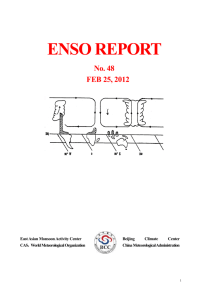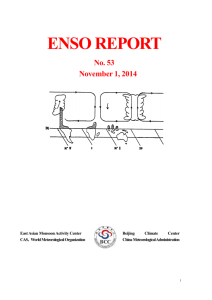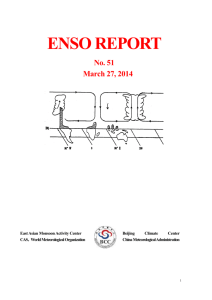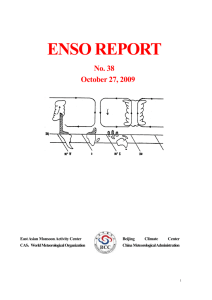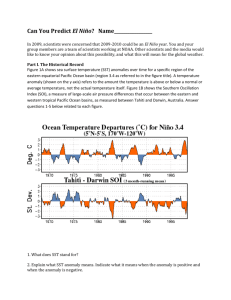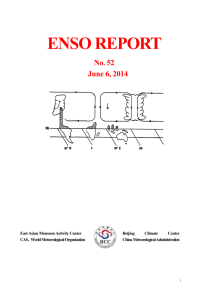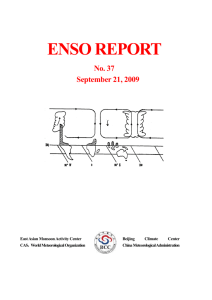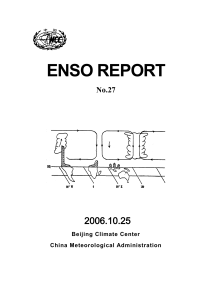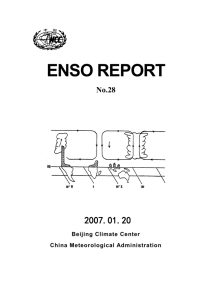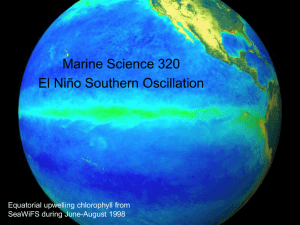enso_e40
advertisement
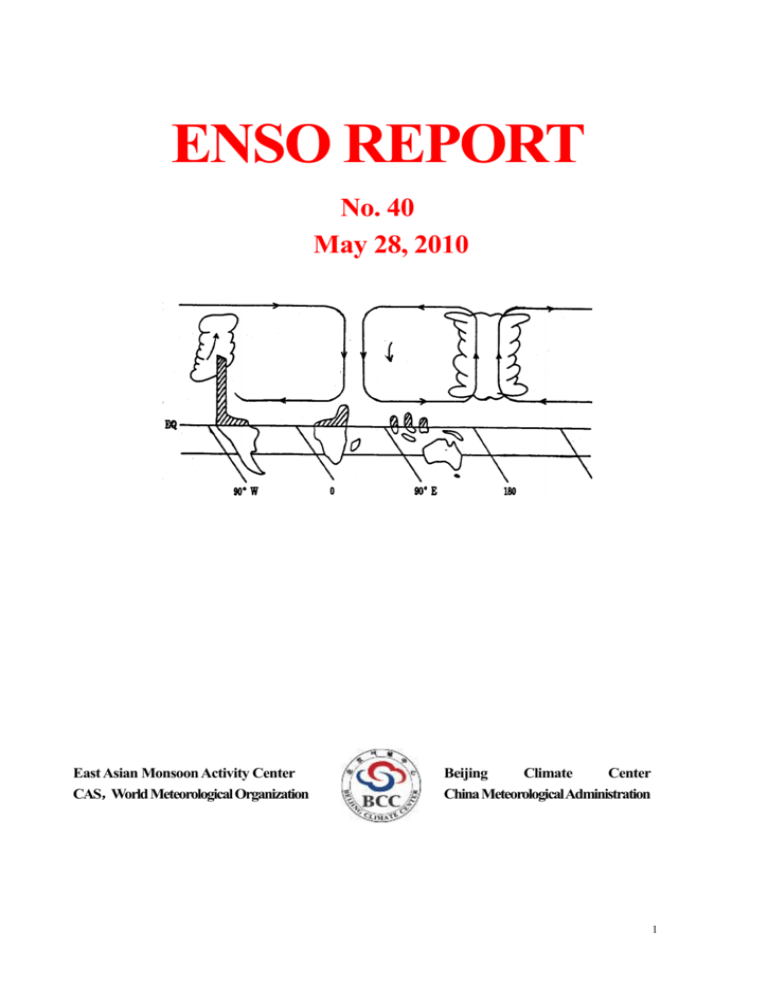
ENSO REPORT No. 40 May 28, 2010 East Asian Monsoon Activity Center CAS,World Meteorological Organization Beijing Climate Center China Meteorological Administration 1 El Niño event ends in May 2010 1. Recent monitoring on ENSO evolution a) Distribution of SSTA The El Niño event of 2009/2010 reached its peak in December 2009 with the Nino Z index of 1.4℃. After that, sea surface temperatures (SSTs) decreased gradually across much of the central and eastern Pacific. In May 2010, the El Niño event weakened significantly and the Nino Z index dropped down to 0.3℃ in the first 25 days (Fig. 1). A band of positive SST anomalies (SSTAs) broke in the middle of the central and eastern Pacific, where slightly negative SSTAs substituted for positive SSTAs (around 140oW). Positive SSTAs above 0.5℃ kept respectively in the equatorial central Pacific and the eastern Pacific east of 120oW (Fig. 2). 2 1.5 1 0.5 SOI NINO3.4 NINOZ 20 10 04 20 10 05 20 09 12 20 09 09 20 09 06 20 09 03 -0.5 20 08 12 20 08 09 0 -1 -1.5 Fig.1 Nino Z, Nino 3.4 SSTA indices (unit: ℃) and SOI (25 days for May 2010) Fig.2 Sea surface temperature anomalies in May 2010 (25 days, unit: ℃) b) Subsurface Temperatures In April 2010, anomalously warm subsurface water decreased evidently in the equatorial central and eastern Pacific. Meanwhile, anomalously cold subsurface water strengthened significantly in the equatorial western Pacific and expended swiftly eastward to 140oW, with the minimum below -3℃. This indicates that the El Niño event ends soon (Fig. 3). 2 Fig. 3 Equatorial depth-longitude section of monthly subsurface ocean temperature anomalies (unit: ℃) for March (left) and April (right) 2010 c) Southern Oscillation The Southern Oscillation Index (SOI) was 1.4 in April 2010 (Fig. 1), with an increase of 2.1 from the previous month. In the first 25 days of May 2010, SOI was 0.5. This indicates that a fast transition of the atmosphere benefits the cold SSTA. d) Tropical Pacific Convections and 850hPa Zonal wind Since mid-March 2010, convection reduced gradually over the equatorial central Pacific. Especially during mid-April and May, convection was suppressed over the equatorial central and eastern Pacific (Fig. 4). At 850hPa, easterly anomalies developed and expended eastward over the equatorial central and western Pacific, while westerly anomalies decreased significantly over the central and eastern equatorial Pacific (Fig. 5). Fig. 4 Time-longitude section of pentad outgoing longwave radiation (OLR) anomalies averaged in 5ºS-5ºN (Units: W/m2) Fig. 5 Time-longitude section of pentad 850hPa zonal wind anomalies averaged in 5ºS-5ºN (Units: m/s) 2. Diagnosis and outlook a) Diagnosis 3 In May 2010, SSTs decreased significantly across much of the equatorial central and eastern Pacific, together with the suppressed convection over the same areas. SOI changed from negative to positive values, and low-level easterly anomalies developed and extended eastward over the equatorial central and western Pacific. Anomalously warm subsurface water weakened evidently under the equatorial central and eastern Pacific, whereas anomalously cold subsurface water in the equatorial central and western Pacific developed and expended rapidly eastward. These tropical atmosphere and ocean features indicate that the El Niño event ends soon, and SSTs will possibly change to the cold conditions in the future 1-3 months across the equatorial central and eastern Pacific. b) Model predictions Most statistical and dynamic models predicted a transition to cold conditions in the second half of 2010, with some models indicating development of a La Niña event. c) Outlook Based on current observations and the aforementioned model forecasts, this El Niño event will not continue and ENSO-neutral conditions begin in May 2010. It is expected that cold conditions of SSTs develop across the equatorial central and eastern Pacific in summer, with a possibility of development of La Niña conditions. 4 BCC operational definitions for El Niño and La Niña Event (condition) El Niño (La Niña) event: which is characterized by a positive(negative) sea-surface temperature departure from normal (for the 1971-2000 base period) in NINO Z (NINO 1+2+3+4) greater (less) than or equal to 0.5℃ (-0.5℃) for at least 6 consecutive months (allowing below (above) 0.5℃(-0.5℃) for only one month) . BCC considers El Niño (La Niña) conditions to occur when the monthly NINO Z index greater (less) than or equal to 0.5℃ (-0.5℃) along with consistent atmospheric features. And, these anomalies must also be forecasted to persist for at least 3 consecutive months. *References 1. On Indices and Indicator of ENSO Episodes, 2000, Acta Metrological Sinica, 58(1): 102-109 2. Redefining ENSO Episode on Changed Reference, 2005, Journal of Tropical Meteorology,2005, 21(1): 72-78 Distribution of the NINO regions for ENSO monitoring Editor: Yuan, Yuan Chief Editor: Wang, Qiyi Technical assistant: Yan, Jinghui BCC’s ENSO monitoring website: http://bcc.cma.gov.cn/en/product.php?PID=67&WCHID=21&ChannelID=67 5


